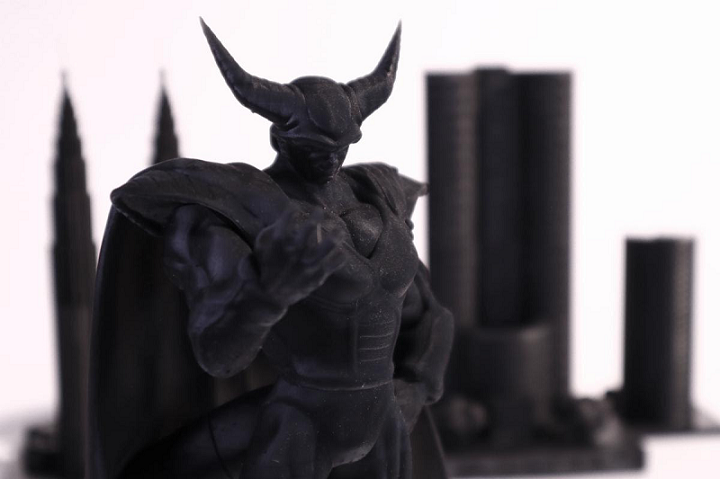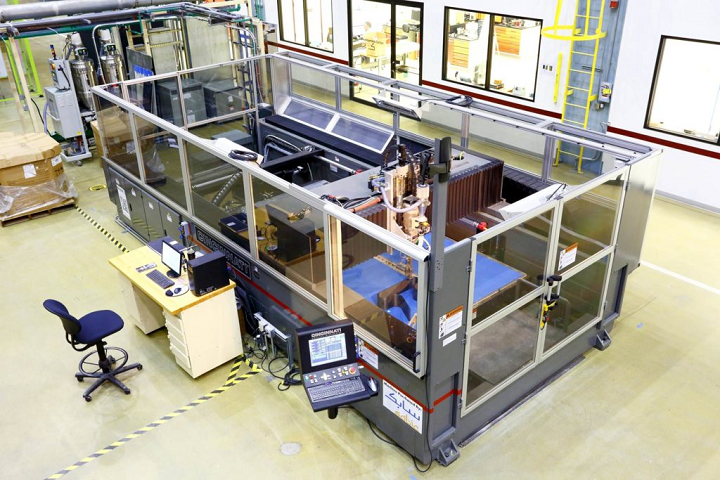3D Printing News Briefs, June 30, 2021: IDM Lab, Weerg, Monocure3D, Carpenter Additive & Link3D, SABIC & Local Motors, Neotech AMT
From a new 3D printer and new materials to integrated software and more, read on for all the interesting stories in today’s 3D Printing News Briefs!
IDM Lab Launches PicoFAB 3D Printer
Italy-based IDM Lab, formerly known as Lumi Industries, has officially launched its new PicoFAB resin 3D printer, which we first heard about last winter, at the recent Arab Health event. The company created the PicoFAB system with a specific purpose in mind, and that was to offer bioprinting researchers, material developers, and research laboratories a better tool for photopolymer testing. Typically, commercial resin 3D printers require a larger amount of resin to print, but the PicoFAB, which includes a stainless steel, sterilizable, and removable resin tank, has this covered.
“The problem is that commercially available resin 3D printers have an average footprint area of 10 x 7cm or more, and therefore to print, at least 100ml of resin is required. This becomes a problem when you want to test a new resin of which you have very small quantities available, because it is very expensive (bioprinting, certified resins) or because you are testing new materials and therefore you prefer to initially produce small quantities of resin,” the company explained in a press release.
“To overcome this problem, we have developed PicoFAB, a 3d printer that allows you to print with just 10ml of resin, in a printing area of 24x24mm at 100mcron of XY resolution and 25/50 / 100micron on the Z axis.”
IDM Lab says that several universities and laboratories are already interested in using its PicoFAB for materials testing.
Weerg Adds Metal Replacement Material to Portfolio
Speaking of materials, another Italian company, Weerg, has introduced the latest addition to its range of 3D printing materials, the Extreme Carbon Fiber+PA12 formula for metal replacement. This thermoplastic polymer is the result of an exclusive formulation developed by the platform’s R&D department, and optimizes all the advantages of two the materials it’s made of, offering excellent chemical resistance, dimensional stability, and advanced mechanical properties. The material, available in a natural black finish, has a performance similar to aluminum 5083, and has higher stiffness and XYZ flexural strength than PA12 alone, thanks to the addition of the carbon fiber, and also absorbs very little moisture, which helps it deliver optimal performance in all conditions. Weerg has implemented six FDM 3D printers dedicated to producing this new Extreme material.
“We have invested in enhancing our R&D department to accelerate the testing of the most innovative open-source materials with the aim of further expanding our offer in the field of 3D printing. The introduction of Extreme™ allows us to propose online the parts and components making process to combine the performance of metals with the versatility of additive manufacturing, with the added value of all the pluses that distinguish the weerg.com platform, among which the extremely competitive costs,” said Weerg Founder Matteo Rigamonti.
The release of Weerg’s new Extreme Carbon Fiber+PA12 is supported by a promotional campaign, complete with discounts for customers looking to test out its performance, and the company also announced that it will soon add additional materials to its range.
Monocure3D Introduces DEEP BLACK to Pro Materials
Another company, Monocure3D, also has a new material it’s introducing: DEEP BLACK, for its PRO range. Once parts and models printed with this material have been cleaned and post-cured, they’ll have a smooth matte finish, and even with super-thin 2 mm walls, will feature a solid, dense, ABS plastic look. The resin was formulated with the company’s in-house urethane base for improved longevity and durability, and is supposedly easy to print, with a low failure formula of 4 x 30s base / 3s normal layers settings on its Mono printers and 4 x 60s base / 10s normal for the RGB printers. Because this is a new material, stock is currently limited, but you can also order direct from the company’s resellers: FEP Shop in the Netherlands, 3DDeliver in Germany, and Atome 3D (soon) in France.
“We are performing our end of year stocktake and transitioning to a brand new website. Please come back and check it out on the 1st July 2021,” Monocure3D states on its website. “If you use the coupon code NEWWEBSITE you will get get 15% off your next order!”
Carpenter Additive Integrates Link3D into Daily Workflow
Moving on, Carpenter Additive has integrated Link3D into its workflow to help refine its team communications and project management; the latter detailed the news in a case study. Because Carpenter Additive experts support customers with a variety of end-to-end manufacturing services, including specialty alloy atomization, metal 3D printing, powder lifecycle management, heat treatment, and services focused on materials data generation, the company was in need of a good way to consolidate its data. Integrating Link3D into its daily workflow allowed Carpenter Additive to develop a more centralized digital thread and data hub, resulting in 22% productivity improvement at manufacturing centers, 14% first print quality improvement, and over 12 hours a week in project management efficiencies.
“Link3D gives management and our commercial team a tool to keep tabs on work order progress without micromanaging. One of the really impactful things was the ability for any of us to log on from anywhere and understand the latest project status. We don’t have to ask or phone for information. We can just log on and see all the multiple moving pieces. This was especially helpful during 2020 when the pandemic forced the majority of our team to work from home,” explained William Herbert, Director of Technology and R&D at Carpenter Additive.
“I think every manufacturing company is going to have to have a digital transformation or be left in the dust. For Carpenter, a one hundred and thirty year old specialty metals manufacturer, additive is a new area that can blaze the trail for digitally enabled manufacturing and workflows. Implementing Link3D in our group shows what’s possible when enabling a digital thread type approach.”
SABIC & Local Motors: 3D Printing Recycling Study
Next-generation vehicle manufacturer Local Motors and chemical company SABIC partnered up to complete a joint study on the feasibility of recycling leftover thermoplastic parts and shavings in order to improve the circularity of large-format additive manufacturing (LFAM). At the moment, there isn’t an established value chain—locating, collecting, and transportation—for reclaiming and reusing post-print LFAM scraps and parts, and degradation from multiple heat cycles is a possibility when it comes to reusing LFAM materials, which breaks down polymer chains, reduces fiber length, and generally affects performance. In the study, SABIC and Local Motors looked into more sustainable ways to landfill these large 3D printed parts, which included analyzing the post-print mechanical properties of SABIC’s LNP THERMOCOMP AM reinforced compound, which Local Motors uses. They found that material from post-production parts and scrap could potentially be reused in LFAM or other manufacturing processes, like injection molding, up to 100%, and help determine a path to circularity and a longer life for LFAM materials. But, gaps in the recycling value chain must be filled to make this a viable option, which will require a collective effort from the overall LFAM community.
“As adoption of large format additive manufacturing accelerates, it is essential to find sustainable alternatives to landfilling large, printed parts. SABIC and Local Motors have investigated the practicality of using mechanically ground scrap material and end of life parts generated from LFAM,” said Walter Thompson, senior applications development engineer at SABIC. “Our study showed great potential for reusing these materials and marks a first step in supporting reuse within the value chain.”
You can check out the full case study here. Additionally, SABIC will be putting together a report of detailed data from the study.
Neotech AMT’s Project for AM Methods of Producing Mechatronics
 A fully additively manufactured luminaire (Photo courtesy of Neotech AMT)
A fully additively manufactured luminaire (Photo courtesy of Neotech AMT)3D printed electronics company Neotech AMT GmbH announced the launch of EU Penta Project AMPERE, in which a consortium of research and industrial partners from Germany and the Netherlands will develop scalable hybrid 4D manufacturing processes for the production of multifunctional mechatronic systems. The consortium partners for this project, which runs until March 31st, 2024, will work together to develop and combine 3D printing technologies for scalable manufacturing of these smart 4D mechatronic products, first for small series and then mass-customized products, while working towards scaling up to high volumes of over 10,000 parts. Smart processes will be used to create novel products that have a combination of integrated electrical, mechanical, and optical functionalities, and by the end of the project, the team will present three product cases—LED luminaires, signal/power electronics, and medical devices—in order to demonstrate their hybrid manufacturing approach.
“The AMPERE project is a hugely exiting and ambitious project in the field of AM and will generate substantial business benefits. The project will enable unique product designs, that for the first time combine mechanical, electrical and optical functionalities produced at the industrial scale,” stated Dr. Martin Hedges, the Managing Director of Neotech. “Furthermore, the flexible nature of the developed production systems will allow faster response to changes in the market and open up new application areas for this emerging technology.”
Subscribe to Our Email Newsletter
Stay up-to-date on all the latest news from the 3D printing industry and receive information and offers from third party vendors.
You May Also Like
Precision at the Microscale: UK Researchers Advance Medical Devices with BMF’s 3D Printing Tech
University of Nottingham researchers are using Boston Micro Fabrication‘s (BMF) 3D printing technology to develop medical devices that improve compatibility with human tissue. Funded by a UK grant, this project...
3D Printing Webinar and Event Roundup: April 21, 2024
It’s another busy week of webinars and events, starting with Hannover Messe in Germany and continuing with Metalcasting Congress, Chinaplas, TechBlick’s Innovation Festival, and more. Stratasys continues its advanced training...
3D Printing Webinar and Event Roundup: March 17, 2024
It’s another busy week of webinars and events, including SALMED 2024 and AM Forum in Berlin. Stratasys continues its in-person training and is offering two webinars, ASTM is holding a...
3D Printed Micro Antenna is 15% Smaller and 6X Lighter
Horizon Microtechnologies has achieved success in creating a high-frequency D-Band horn antenna through micro 3D printing. However, this achievement did not rely solely on 3D printing; it involved a combination...


































